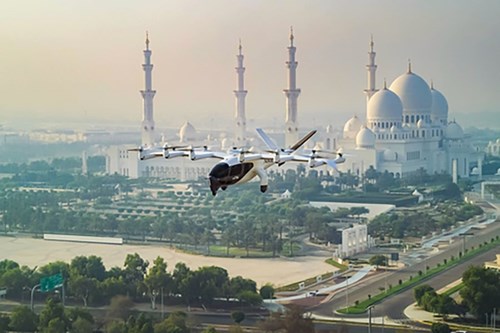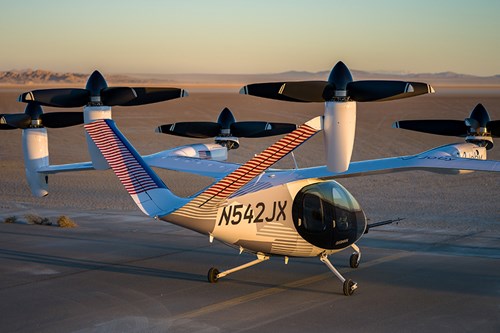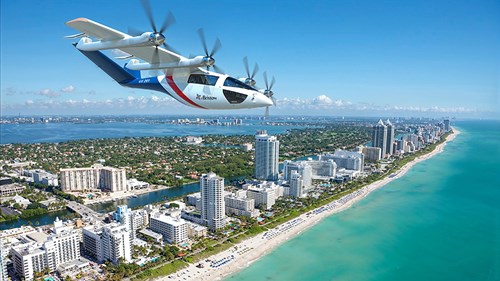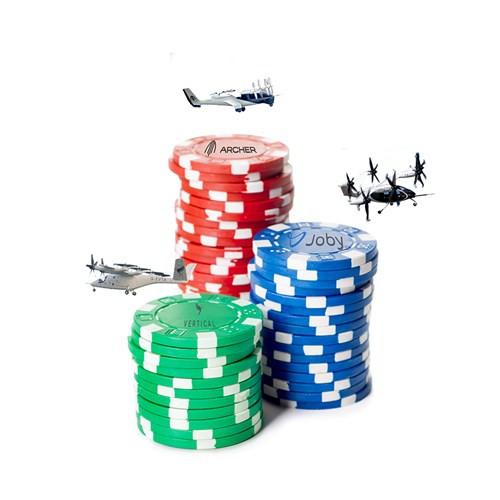As eVTOL developers gamble on leaping final hurdles, how far away are we from flying taxis entering service? BILL SWEETMAN casts an eye over the ‘agonisingly slow’ progress in the race towards certification?
The urban air mobility (UAM) table is groaning under the weight of the inexorably rising stack of gambling chips, $20bn by late 2024, according to McKinsey analysts. Every new flight milestone is greeted with a chorus of favourable tweets and Reddit upvotes. This year, we are told, is the year when leaders, Archer Aviation and Joby Aviation will carry their first passengers – in the United Arab Emirates (UAE), not the US.
Archer’s agreement to provide an air taxi service for the 2028 Olympic Games in Los Angeles was not announced by a mere press release but on Jimmy Kimmel’s top-rated late-night talk show. The deal with LA28, the organising company for the games, includes ‘storytelling opportunities’ throughout the event, and Archer’s Midnight vehicle is being promoted as a magic carpet that will allow well-heeled visitors to catch multiple events in different locales even if they are scheduled minutes apart.
The Washington Post in December presented a glowing account of the progress of Archer and Joby, free of the slightest doubt that they will deliver affordable air taxi services on schedule, even though the 14-mile Archer flight that the reporter witnessed was no longer than the Wrights were flying at Huffman Prairie in 1905. Joby founder, JoeBen Bevirt was quoted as saying, grandly enough, that UAM “will allow us to change our relationship with space and time.”
Competitors fall by the wayside
Lilium Jet folded after being unable to find a buyer. (Lilium)
However, not everything is going smoothly. Sergio Cecutta of SMG Consulting, in an Aviation Week webinar on 3 June, presented an estimated timeline that showed Archer earning an operating certificate in the second quarter of 2028, with no margin at all, just three years out, to make the Olympics.
Two European contenders ran out of money late last year: Volocopter, developing a low-end vehicle with multiple fixed rotors, which had tried and failed to deliver air taxi services for the 2024 Paris Olympics; and Lilium, proposing ambitious and high-speed vehicles. Neither dented the confidence of the community: investors expect a winnowing-out among the dozens of projects. However, Airbus paused (stopped) its City Airbus programme in January, saying that the necessary battery technology was not in sight, following Rolls-Royce’s exit from electric propulsion in 2023.
Directly after its Olympic announcement, Archer came under attack from Culper Research, a company that specialises in acquiring bad news about a company and then taking short positions in its stock so it can profit if it declines. Archer’s stock brushed off the report but it left open questions and was a reminder that the UAM players are cagey at best about disclosing actual progress and use their own their terminology for different phases of certification.
None has flown a type-conforming prototype, nor flown an out-and-return flight, with a vertical landing and take-off at the midpoint, on a single charge. Cecutta, generally bullish on UAM, does not think that the lack of multi-segment demonstrations is important. “Those are big batteries,” he says “and four or five segments should be possible under ideal conditions.” He did not offer a suggestion as to why the market leaders have not performed what would be a convincing argument that the technology is on track to deliver a real service to cities around the world.
The Culper affair underscores an unusual aspect of the UAM universe: the degree to which the companies own the narrative. An ecosystem of media sites, consultancies and conference organisers has grown up to dominate the UAM conversation but it depends on the sector’s success. The long-established Helicopter Association International was renamed as the Vertical Flight Society after an influx of funds from eVTOL companies.
Archer does not have an identifiable media contact. Archer did not acknowledge a request for information associated with this story; Joby did not provide an answer. The companies have not provided access to technical experts, preferring to let their founders talk in generalities and speak to investor-focused podcasts.
Full speed ahead in the Gulf

Archer Aviation is planning to make Abu Dhabi its launch market. (Archer)
One result of this media ‘greyout’ is that the biggest strategic shift in UAM over the past year has been treated as regular news: the agreements between Joby, Archer and the United Arab Emirates to launch passenger services this year with support from the UAE General Civil Aviation Authority – Archer in Abu Dhabi and Joby in Dubai.
There are conflicting messages on what this means. Some sources are treating this as a test operation, learning lessons that will facilitate and speed up US certification rather than seeking a fast track to carrying paying passengers, a beta test with humans on board. However, Joby Executive Chairman, Paul Sciarra told the online publication, The Air Current last year: “You have certain markets in the Middle East that are definitely willing to move heaven and Earth to be first to market” – a phrase with a clear meaning – “with this technology.”
There are two clear implications to this. First, Joby and Archer would not be expending effort on UAE certification if it was merely months ahead of US certification, which would provide UAE approval via reciprocity. Indeed, any such effort diverts flight hardware and experienced people from US certification through the end of this year and beyond. Second, it is a major change in how type and production certification are done. In almost every case, the certification process happens in the jurisdiction where the development is done and the intellectual property is held by authorities who have a long legacy of this work. The GCAA has no background in type certification.
Gulf opinionators appear to be in no doubt that the idea is to accelerate certification beyond the FAA’s pace. “[The] air taxi race needs a ‘warp speed’ push — not bureaucratic brakes,” commented the Gulf News website. “Rigorous certification and safety standards are being put in place, often sequentially – instead of in parallel – likely to delay their rollout where they’re most needed. This marks a notable contrast between Asia’s bold push for air taxi services and the more cautious approach of US and European regulators. This delays deployment, even when early models show strong safety potential, proven by real-time flight test data.”
This kind of commentary reflects a common technology-world view that regulation is bureaucracy and an impediment to innovation, and at best a box-checking exercise. Archer and Joby are deliberately choosing to have their vehicles operated in states best described as corporate monarchies, where government enables business, and the prestige of the state is critical, a form of government favoured by politically influential tech entrepreneurs, like Elon Musk and Peter Thiel. When Cecutta says “we have tech people now in aerospace, with a very, very different mindset than legacy companies,” it is hard to argue with him. However, the object of type certification, versus beta testing, is to demonstrate, before you enter service, that the vehicle will not have an accident resulting in multiple fatalities in more than one in 100 million flights.
FBW and failure modes

Joby is another eVTOL manufacturer making its way towards certification. (Joby)
The core discipline leading to certification is failure modes, effects and criticality analysis, or FMECA. Essentially, this is a summing-up of all individual failures, at a component level, to ensure that they will not, individually, in combination or through cascade effects, lead to a catastrophic result.
FMECA for radically new aircraft types “is always problematic,” notes Carlos Fenny, a veteran engineer with long experience in fly-by-wire (FBW). “Component and system failure rates are based on existing component designs,” Fenny continues. “But for all new component and system designs, failure rates and modes of potential failures can only be educated guesses.”
Fenny is one of a number of UAM-sceptical engineers who have been commenting on LinkedIn and other platforms, and like some others, he has experience on or adjacent to the Bell 525 and Leonardo AW609 programmes, the only two commercial rotorcraft launched so far that use FBW. Neither has yet been certificated after long delays.
FBW rotorcraft lack the same dynamic stability (inertia) as a fixed-wing aircraft and normally operate at lower altitude, Fenny argues. FMECA may show that a transient failure that is acceptable on a fixed-wing aircraft is much more hazardous on a rotorcraft. The Bell 525 and AW609 incorporate triplex control and actuation systems, which can provide true redundancy but increases complexity and leads to a higher probability of failure, making it harder to reach reliability goals.
Cecutta does not share these concerns: “Issues with FBW and batteries are greatly exaggerated by naysayers. It won’t be a walk in the park, but it won’t be another AW609.”
Also asking questions is aircraft designer, Dan Raymer: “The basic conundrum of vertical flight – you need lots of disk area for hover efficiency but far less for efficient forward flight. What to do? Tilt them all forward? Has problems. Tilt some forward and shut some others off? Has problems.”
Raymer, an independent thinker with a non-American sense of irony, adds: “Luckily, thanks to the near-insanity of the investor class, we are almost at the point of completing the best possible trade study for questions like this.”
This points to the key difference between Archer’s Midnight and Joby’s S4, and to one of the main points of attack in the Culper report. The S4 has six large (estimated diameter 9ft 6in) fully tilting proprotors arranged so that they form a hexagon in vertical mode. Midnight has six wing-mounted booms with tilting proprotors in front and (apparently) fixed-pitch, two-blade rotors in the rear, all around 6ft in diameter. Both have a total disk area of about 340ft2.
Videos and images of Archer’s first transition flight in June 2024 showed that the aft rotors were replaced by four-blade units, possibly variable-pitch, which continued to rotate throughout the flight. This would provide more control authority and lower vibration in transition, but the four-blade rotors cannot be stopped in cruise without imposing excessive loads on the booms. (The rigid two-blade units can be stopped with blades fore and aft.) As observers noted, this will incur a drag penalty and complicate stability in forward flight. Archer performed its first vertical flight on 2 June, but in a conventional take-off and landing mode.
On other eVTOL issues, aerodynamicist, Richard Brown cautions that progress has been “agonisingly slow” in the past year. He continues to emphasise the potential for operational limits due to downwash and outwash from 6,000-6,500lb-class aircraft with high disk loading.
An FAA study released last December “ended up by doing more harm to the industry than good, especially given the implication from the way the data was presented that hurricane-force winds might be embedded in the field.” Still, Brown suggests, the size of outwash safety zones is being underestimated, even though it will have a direct impact on how many eVTOL operations can be carried out from a vertiport of a given size.
Predicting VRS for EVTOLs

Aviation services provider Bristow is betting heavily on the potential of eVTOLs. (Bristow)
However, Brown notes some more disturbing commentary on vortex ring state (VRS), a potentially dangerous aerodynamic condition to which high-disk-loading aircraft are particularly susceptible. “It’s largely been replaced as the issue du jour by outwash. With a collective ‘phew’,” he says.
In particular, Brown notes a comment by Joby founder, JoeBen Bevirt at the tech leaders’ All-In Summit in September 2024. “There’s this thing called VRS that affects VTOL aircraft, but [with Joby’s S4] you aren’t going to have all six rotors go in and out of VRS at the same time.”
As Brown points out, that is the problem. If an eVTOL aircraft has an uncommanded roll or pitch movement, the flight control system must determine whether that is due to a gust or a VRS encounter – and the correct response in one case will worsen the problem in the other. “The situation is not helped by the engineering community having been sold on a particularly dodgy analytic technique that gives very flawed results in terms of VRS prediction.”
One major external issue facing the eVTOL industry is the attitude of the US administration, where policy since Trump’s inauguration has been mercurial at best, with the latest move in June seeing the White House issue an Executive Order to fast track US adoption of drones and eVTOLs. The campaign had made an issue of the potential for China to capture the lead in UAM – but the FAA was quickly sideswiped after the inauguration by a series of accidents and incidents, the worst being a rotorcraft-to-airliner collision less than three miles from the US Capitol, taking 67 lives, followed by summer chaos at Newark and some other airports due to ATC staff shortages and antiquated equipment.
The DC area’s heavy use of helicopters for Pentagon and other VIP traffic, as well as law enforcement, had made it one of the most rotorcraft-heavy metro areas in the US. Since the accident, most operations other than Marine One have been shut down.
Summary

Cashing in their chips? eVTOL developers are gambling on a smooth path to certification. (Wayne Davis/RAeS)
Those are top-level issues. We still have very little insight into how much eVTOL rides will cost, how many people will choose them over slower, but door-to-door surface transportation, or how people will react to eVTOL rides in low cloud and foul weather. Nor do we know how the greater population will react to vertiports in their neighbourhood.
However, we do have a pretty clear idea about why the eVTOL-world does not have much interest in asking those questions.
